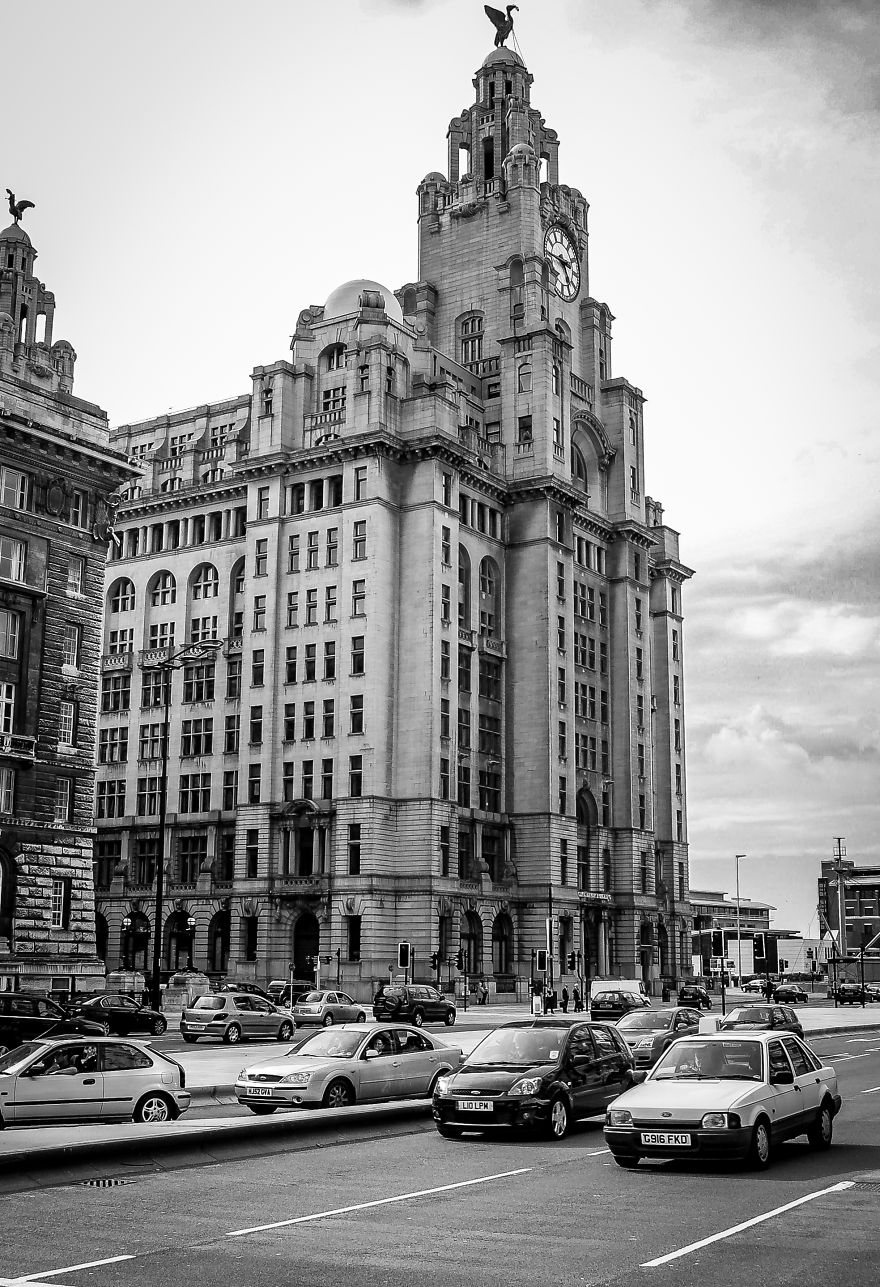A Sight Of Liverpool
The Royal liver Building.
Opened in 1911, the building is the purpose-built home of the Royal Liver Assurance group, which had been set up in the city in 1850 to provide locals with assistance related to losing a wage-earning relative. One of the first buildings in the world to be built using reinforced concrete, the Royal Liver Building stands at 98.2 m (322 ft) tall to the top of the spires, and 50.9 m (167 ft) to the main roof. It was the tallest storied building in Europe from completion until 1932[5] and the tallest in the United Kingdom until 1961. The Royal Liver Building is now however only the joint-fourth tallest structure in the City of Liverpool, having been overtaken in height by West Tower, Radio City Tower and Liverpool Cathedral.
Today the Royal Liver Building is one of the most recognizable landmarks in the city of Liverpool and is home to two fabled Liver Birds that watch over the city and the sea. Legend has it that were these two birds to fly away, then the city would cease to exist.
In 1907 the Royal Liver Group had over 6,000 employees and given the need for larger premises the company gave the go-ahead for the construction of a new head office. Designed by Walter Aubrey Thomas, the foundation stone for the building was laid on 11 May 1908 and just 3 years later, on 19 July 1911, the building was officially opened by Lord Sheffield.[6] The building became the first major structure in Britain, and one of the first buildings in the world, to be constructed using reinforced concrete,[7] and given the building’s radical design was considered by some to be impossible to build.[6]
Since its completion in 1911, it has overlooked the River Mersey from its waterfront location on the Pier Head and forms one of the ‘Three Graces’ along with the Port of Liverpool Building and the Cunard Building. This is reflected in the building’s Grade I listed building status. It stands at 98.2 m (322 ft) tall and has 13 floors.
The building is crowned by a pair of clock towers: as a ship passed along the river, mariners could tell the time from these. The clocks were made by Gent and Co. of Leicester.[8] The clock faces are 7.6 m (25 ft) in diameter, larger than those of London’s famous landmark Big Ben, holding the distinction of being the largest electronically driven clocks in the UK.[9] They were originally named George clocks, because they were started at the precise time that King George V was crowned on 22 June 1911.[10] In 1953 electronic chimes were installed to serve as a memorial to the members of the Royal Liver Friendly Society who died during the two World Wars. During hours of darkness, the clock dials are illuminated.
Atop each tower stand the mythical Liver Birds, designed by Carl Bernard Bartels. Popular legend has it that while one giant bird looks out over the city to protect its people, the other bird looks out to sea at the new sailors coming in to port. Alternatively, local legend states one Liver Bird is male, looking inland to see if the pubs are open, whilst the other is female, looking out to sea to see if there are any handsome sailors coming up the river. Yet another local legend, reflecting Liverpudlians’ cynicism, avers that every time a virgin walks across the Pier Head, the Liver Birds flap their wings. It is also said that, if one of the birds were to fly away the city of Liverpool would cease to exist, thus adding to the mystery of the birds. As a result, both birds are chained to the domes upon which they stand; although this could simply be because the originally gilded Liver birds, of a moulded and hammered copper construction (that is itself fixed onto a rolled-steel armature) are eighteen feet high, ten feet long and themselves carry in their beaks an intricately cast sprig of seaweed. Additionally, however, their heads are three-and-a-half feet long, their wing spread is twelve feet and their legs measure two feet in circumference. The two birds – officially cormorants – have identical and almost traditional poses, standing upright with half-raised wings.
During the early 1950s the sixth floor was occupied and used by No 3 Movements Unit (Embarkation) of the Royal Air Force, overseeing and controlling the movement of RAF personnel and goods through the port.
The building remains the head office for the Royal Liver Assurance. More akin to the early tall American skyscrapers, the Royal Liver Building closely resembles H. H. Richardson’s Allegheny Court House (built in 1884) and Adler and Sullivan’s Schiller Theatre – with no definitive exterior styling but eclectic references to the Baroque and Byzantine.
http://www.royalliverbuildingvenue.co.uk/
A sight of Liverpool
The Royal liver Building.
Opened in 1911, the building is the purpose-built home of the Royal Liver Assurance group, which had been set up in the city in 1850 to provide locals with assistance related to losing a wage-earning relative. One of the first buildings in the world to be built using reinforced concrete, the Royal Liver Building stands at 98.2 m (322 ft) tall to the top of the spires, and 50.9 m (167 ft) to the main roof. It was the tallest storied building in Europe from completion until 1932[5] and the tallest in the United Kingdom until 1961. The Royal Liver Building is now however only the joint-fourth tallest structure in the City of Liverpool, having been overtaken in height by West Tower, Radio City Tower and Liverpool Cathedral.
Today the Royal Liver Building is one of the most recognizable landmarks in the city of Liverpool and is home to two fabled Liver Birds that watch over the city and the sea. Legend has it that were these two birds to fly away, then the city would cease to exist.
In 1907 the Royal Liver Group had over 6,000 employees and given the need for larger premises the company gave the go-ahead for the construction of a new head office. Designed by Walter Aubrey Thomas, the foundation stone for the building was laid on 11 May 1908 and just 3 years later, on 19 July 1911, the building was officially opened by Lord Sheffield.[6] The building became the first major structure in Britain, and one of the first buildings in the world, to be constructed using reinforced concrete,[7] and given the building’s radical design was considered by some to be impossible to build.[6]
Since its completion in 1911, it has overlooked the River Mersey from its waterfront location on the Pier Head and forms one of the ‘Three Graces’ along with the Port of Liverpool Building and the Cunard Building. This is reflected in the building’s Grade I listed building status. It stands at 98.2 m (322 ft) tall and has 13 floors.
The building is crowned by a pair of clock towers: as a ship passed along the river, mariners could tell the time from these. The clocks were made by Gent and Co. of Leicester.[8] The clock faces are 7.6 m (25 ft) in diameter, larger than those of London’s famous landmark Big Ben, holding the distinction of being the largest electronically driven clocks in the UK.[9] They were originally named George clocks, because they were started at the precise time that King George V was crowned on 22 June 1911.[10] In 1953 electronic chimes were installed to serve as a memorial to the members of the Royal Liver Friendly Society who died during the two World Wars. During hours of darkness, the clock dials are illuminated.
Atop each tower stand the mythical Liver Birds, designed by Carl Bernard Bartels. Popular legend has it that while one giant bird looks out over the city to protect its people, the other bird looks out to sea at the new sailors coming in to port. Alternatively, local legend states one Liver Bird is male, looking inland to see if the pubs are open, whilst the other is female, looking out to sea to see if there are any handsome sailors coming up the river. Yet another local legend, reflecting Liverpudlians’ cynicism, avers that every time a virgin walks across the Pier Head, the Liver Birds flap their wings. It is also said that, if one of the birds were to fly away the city of Liverpool would cease to exist, thus adding to the mystery of the birds. As a result, both birds are chained to the domes upon which they stand; although this could simply be because the originally gilded Liver birds, of a moulded and hammered copper construction (that is itself fixed onto a rolled-steel armature) are eighteen feet high, ten feet long and themselves carry in their beaks an intricately cast sprig of seaweed. Additionally, however, their heads are three-and-a-half feet long, their wing spread is twelve feet and their legs measure two feet in circumference. The two birds – officially cormorants – have identical and almost traditional poses, standing upright with half-raised wings.
During the early 1950s the sixth floor was occupied and used by No 3 Movements Unit (Embarkation) of the Royal Air Force, overseeing and controlling the movement of RAF personnel and goods through the port.
The building remains the head office for the Royal Liver Assurance. More akin to the early tall American skyscrapers, the Royal Liver Building closely resembles H. H. Richardson’s Allegheny Court House (built in 1884) and Adler and Sullivan’s Schiller Theatre – with no definitive exterior styling but eclectic references to the Baroque and Byzantine.
http://www.royalliverbuildingvenue.co.uk/




6
0